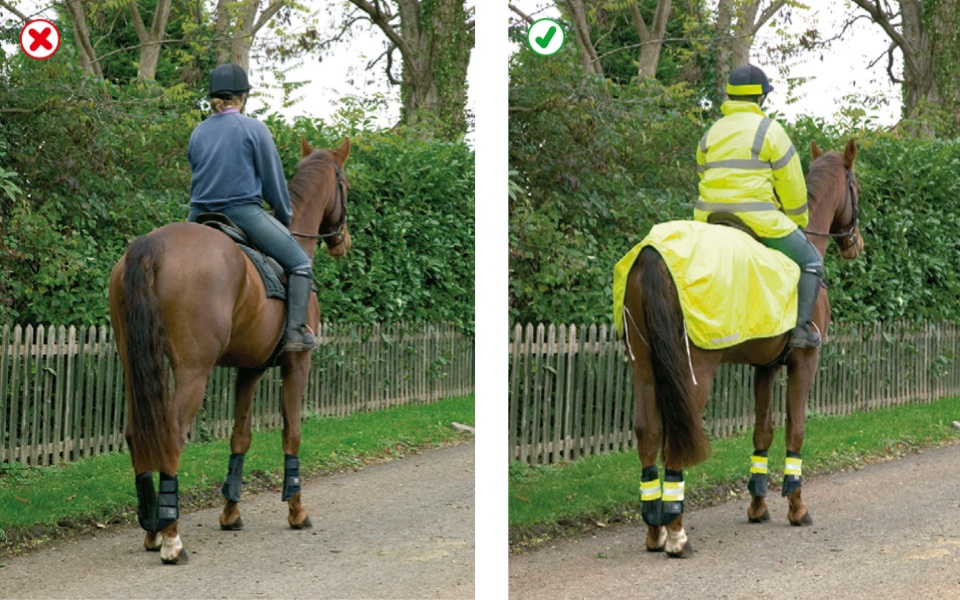Highway Code Updated – when passing horses: 10mph and minimum 2m distance

The highway code has been updated to make the roads safer for horses, cyclists and pedestrians. Rule 215 applies to road users passing horses:
Rule 215
Horse riders and horse-drawn vehicles. Be particularly careful of horse riders and horse-drawn vehicles especially when approaching, overtaking, passing or moving away. Always pass wide and slowly. When you see a horse on a road, you should slow down to a maximum of 10 mph. Be patient, do not sound your horn or rev your engine. When safe to do so, pass wide and slow, allowing at least 2 metres of space.
Feral or semi feral ponies found in areas such as the New Forest, Exmoor and Dartmoor require the same consideration as ridden horses when approaching or passing.
Horse riders are often children, so take extra care and remember riders may ride in double file when escorting a young or inexperienced horse or rider. Look out for horse riders’ and horse drivers’ signals and heed a request to slow down or stop. Take great care and treat all horses as a potential hazard; they can be unpredictable, despite the efforts of their rider/driver. Remember there are three brains at work when you pass a horse; the rider’s, the driver’s and the horse’s. Do not forget horses are flight animals and can move incredibly quickly if startled.
The highway code has also covers riders in relation to visibility on the road:
Rule 49
Safety equipment. Children under the age of 14 MUST wear a helmet which complies with the Regulations. It MUST be fastened securely. Other riders should also follow these requirements. These requirements do not apply to a child who is a follower of the Sikh religion while wearing a turban.
Laws H(PHYR)A sect 1 & H(PHYR)R reg 3
Rule 50
Other clothing. You should wear
- boots or shoes with hard soles and heels
- light-coloured or fluorescent clothing in daylight
- reflective clothing if you have to ride at night or in poor visibility.

Rule 50: Help yourself to be seen
Rule 51
At night. It is safer not to ride on the road at night or in poor visibility, but if you do, make sure you wear reflective clothing and your horse has reflective bands above the fetlock joints. A light which shows white to the front and red to the rear should be fitted, with a band, to the rider’s right arm and/or leg/riding boot. If you are leading a horse at night, carry a light in your right hand, showing white to the front and red to the rear, and wear reflective clothing on both you and your horse. It is strongly recommended that a fluorescent/reflective tail guard is also worn by your horse.
Riding
Rule 52
Before you take a horse or horse drawn vehicle on to the road, you should
- ensure all tack fits well and is in good condition
- make sure you can control the horse.
If you are an inexperienced horse rider or have not ridden for a while, consider taking the Ride Safe Award from the British Horse Society. The Ride Safe Award provides a foundation for any horse rider to be safe and knowledgeable when riding in all environments but particularly on the road. For more information, see www.bhs.org.uk
Always ride with other, less nervous horses if you think that your horse will be nervous of traffic. Never ride a horse without both a saddle and bridle.
Rule 53
Before riding off or turning, look behind you to make sure it is safe, then give a clear arm signal.
When riding on the road, you should
- keep to the left
- keep both hands on the reins unless you are signalling
- keep both feet in the stirrups
- not carry another person
- not carry anything which might affect your balance or get tangled up with the reins
- keep a horse you are leading to your left
- move in the direction of the traffic flow in a one-way street
- never ride more than two abreast, and ride in single file on narrow or busy roads and when riding round bends.
Rule 54
You MUST NOT take a horse onto a footpath or pavement, and you should not take a horse onto a cycle track. Use a bridleway where possible. Equestrian crossings may be provided for horse riders to cross the road and you should use these where available (see Rule 27). You should dismount at level crossings where a ‘horse rider dismount’ sign is displayed.
Laws HA 1835 sect 72 & R(S)A sect 129(5)




